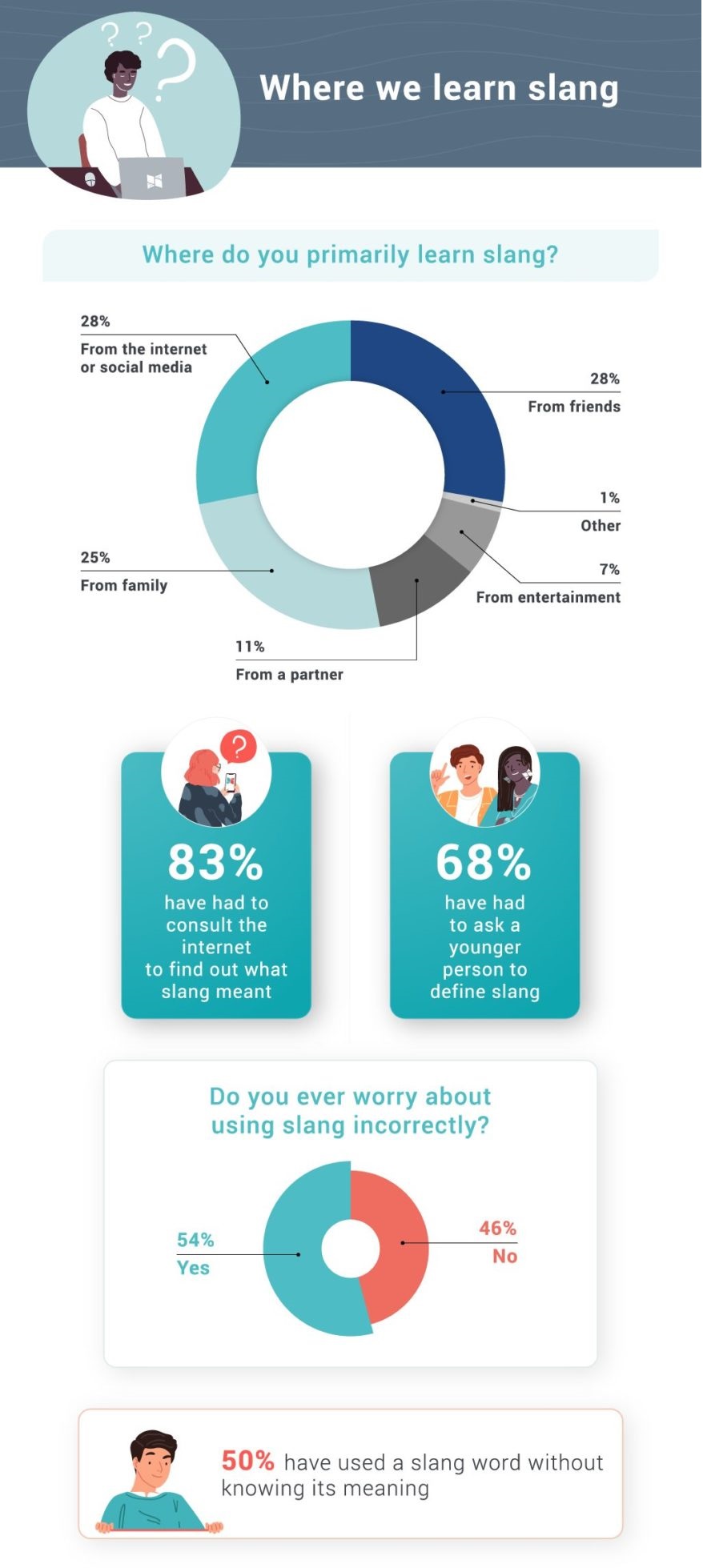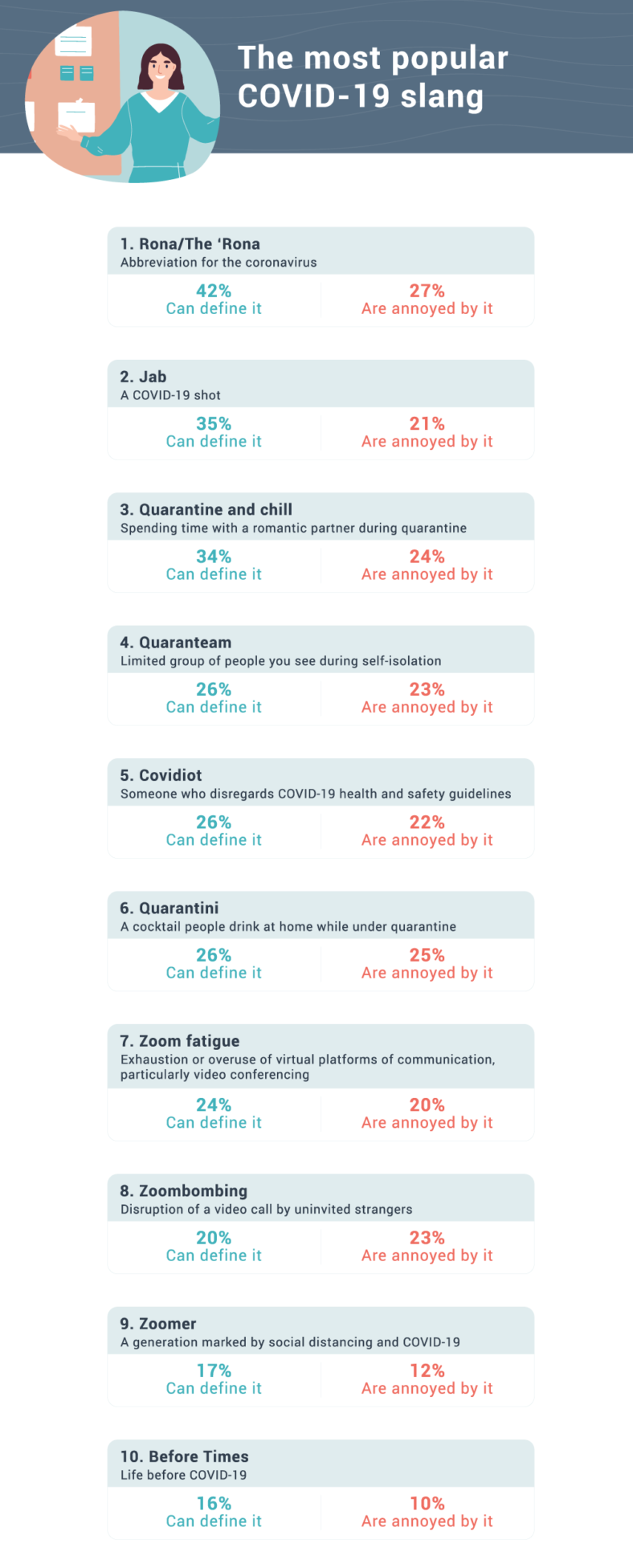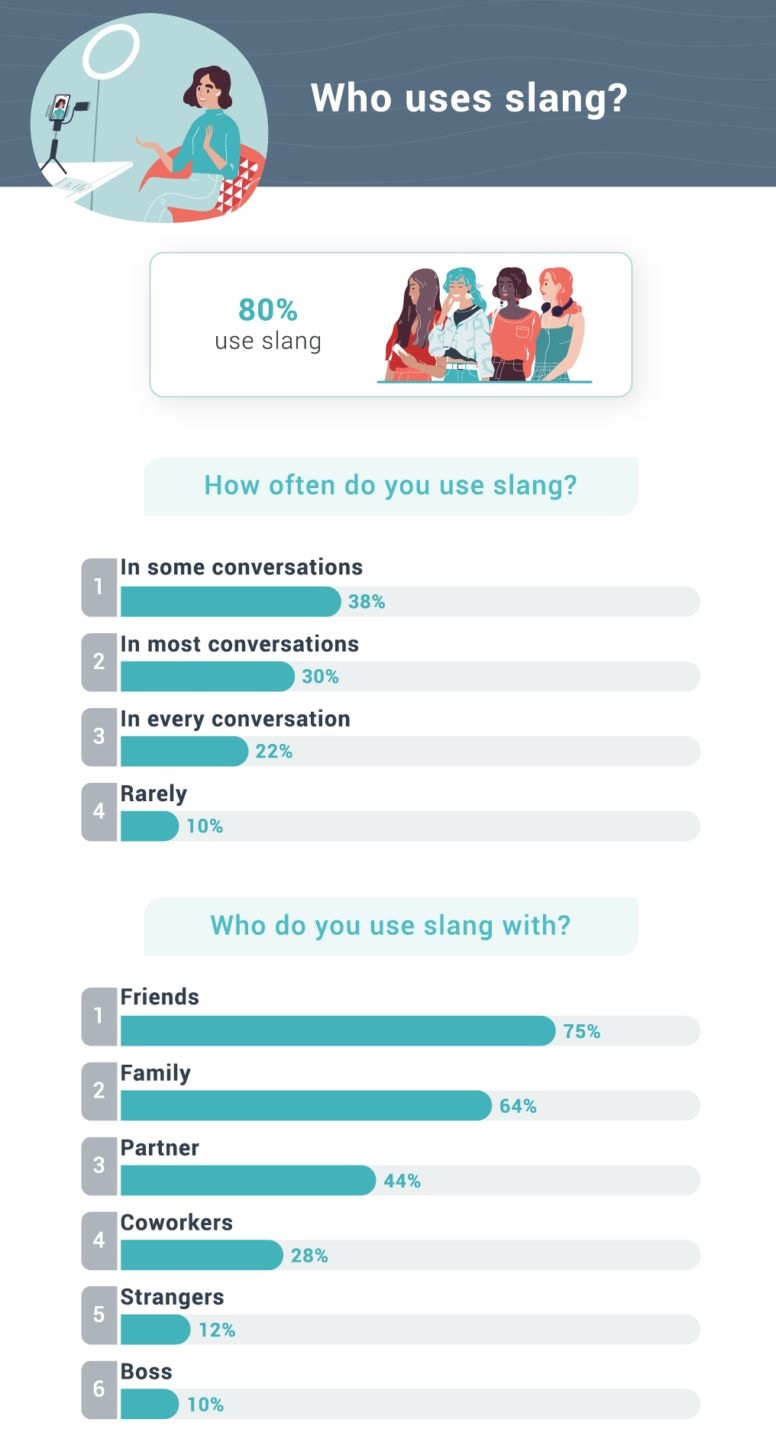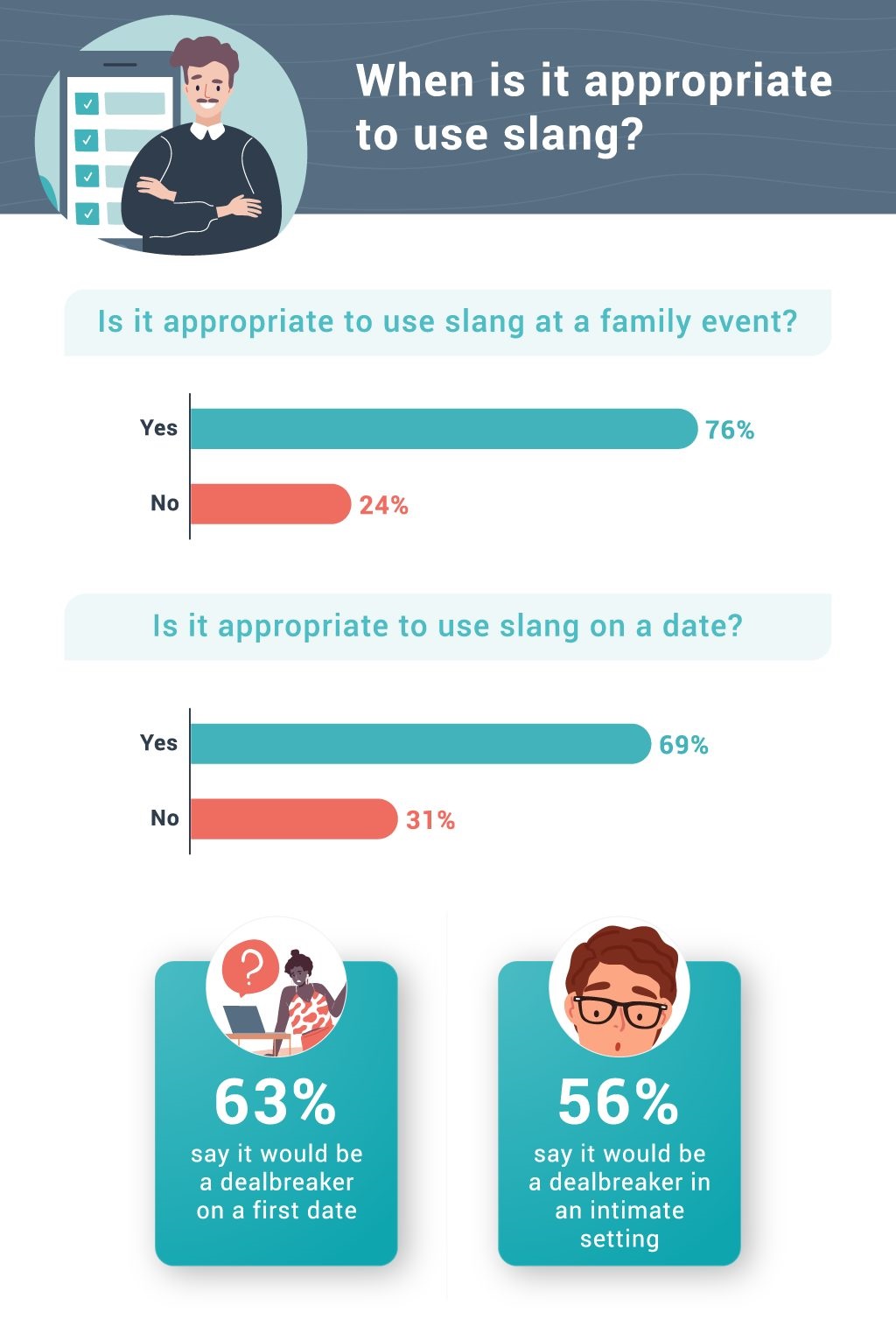Almost daily, we encounter unfamiliar words or phrases, prompting curiosity about their origins and meanings.
Language evolution used to be a slow process, with new terms taking decades to become widely adopted. However, our increased connectivity and rapid communication have accelerated the introduction of new words into our vocabulary, regardless of location. Just in the spring of 2021, over 300 new words, revisions, and definitions were incorporated into the dictionary, including “5G,” “snack,” and “yeet.”
We conducted a survey of approximately 2,000 individuals who speak English to gauge their opinions regarding this aspect of language.
What is your English level?
Find out your A1 A2 B1 B2 C1 C2 level of English with our quick, free online test.
Key findings
– One-fifth of Americans acknowledge employing slang in every discussion.
– Half of Americans incorporate slang expressions into their conversations without comprehending their meanings.
– The most widely recognized slang terms and phrases in the United States include “ghosted,” “salty,” and “on point.”
– Nearly six in ten Americans are unfamiliar with the meaning of the term ‘Rona.’
– Slang usage tends to irritate 66% of parents, in contrast to 46% of individuals without children.
– 46% of Americans believe it’s acceptable to use slang in a professional context, with 42% willing to use it in the presence of their supervisor.
Where do we learn slang?
Regardless of our personal feelings toward it, we must acquire this type of language from specific sources. But where can we find it?
For a majority of people, slang is predominantly acquired from friends, the internet, and social media, accounting for 56% of the sources. Other outlets include learning it from fellow students or:
1. “I learn the latest ‘cool’ words and phrases from my children; they help me stay current with the language trends of today.”
2. “Before the onset of COVID, I picked up slang at my workplace, which had a significant number of employees in their late teens to thirties.”
For the majority of respondents, the proper usage of slang doesn’t cause much concern. Approximately 46% express no worries about using it incorrectly, and half admit to using slang without a clear understanding of its meaning.

The most popular slang in America right now
Despite a significant portion of the population finding slang bothersome, its prevalence continues to grow. In fact, a substantial 80% of Americans acknowledge using slang, with one in five incorporating it into every conversation.
To determine the most frequently used slang terms, we inquired about those that respondents felt comfortable using in a sentence. Approximately half of the participants were familiar with and understood the term “ghosted,” while 48% recognized both “salty” and “on point.”

Are you C1 Advanced English?
Get your C1 Advanced English certificate now!
✓ Add your certificate to your resume
⭐ ⭐ ⭐ ⭐ ⭐
Explore American slang! Below, you’ll discover a valuable compilation of prevalent American slang expressions, along with their meanings and illustrative examples. Acquiring these slang terms can enhance your ability to engage in everyday English conversations with the fluency of a native speaker.
This is the authentic language used in everyday life in the United States – the kind of language you typically won’t encounter in an ESL classroom.
Here are some crucial slang terms for individuals learning English.
Slang Words -> Meaning
1. Dude -> Guy
2. Ride -> Car
3. Jacked -> Shoes
4. Keep it real -> Be yourself
5. Money -> High quality
6. My bad -> My mistake
7. Off the chain -> Very cool
8. Props -> Proper respect
9. Sick -> Cool (Teen Slang)
10. Creeper -> A weird person
11. Swag -> Style
12. Tool -> A stupid person
13. Bro -> Friend
14. Uber -> The ultimate
15. Hot -> Attractive
16. Boo -> Boyfriend or girlfriend
17. Badass -> Ultra-cool person
18. Awesome -> Exciting
19. Nada -> Nothing
20. On fleek -> Attractive or fashionable
21. Hitched -> Two people have married
22. Bombed -> Completely fail something
23. Cool -> Great, fantastic
24. Fly -> Really young and hip
25. Bestie -> Best friends
26. Asap -> As soon as possible (texting abbreviations)
27. Bail -> Leaving in a hurry
Slang that originated from COVID-19
Emergencies often give rise to entirely new sets of words and phrases. During wartime, for instance, terms like “ammo,” “AWOL,” “FUBAR,” and “civvies” emerged. In the case of our contemporary crisis, the COVID-19 pandemic, a whole new lexicon came into existence. The Oxford English Dictionary even issued updates to monitor the impact of the pandemic on the English language.
These updates encompassed formal terminology such as “COVID-19” itself and “frontliner.” The OED also placed somewhat slang-like words like “maskne” and “quarantini” on its watchlist. But which of these terms are most recognized by Americans?
The most prevalent term was “Rona” or “The Rona,” an abbreviation for “coronavirus,” known to 42% of respondents. This was followed by “jab” (referring to a vaccine shot) at 35%, and “quarantine and chill” at 34%. Other words familiar to Americans included “maskne” (mask-induced acne), “long-hauler” (indicating individuals experiencing long-term effects), and “ghost kitchen” (a facility for preparing delivery-only meals).
Your content goes here. Edit or remove this text inline or in the module Content settings. You can also style every aspect of this content in the module Design settings and even apply custom CSS to this text in the module Advanced settings.

The most annoying slang in US
For every slang expression we have an affinity for, there’s a slang term that irks us, and some are more aggravating than others. “OK boomer” claimed the title of the most detested slang on our list, potentially offending a considerable number of baby boomers. It shared the top ranking with “bae,” a contemporary slang term for a significant other, both garnering a 29% disapproval rate.
Trailing closely at 28% disapproval was “Bye, Felicia,” a dismissive phrase originally popularized by the character played by Ice Cube in the 1995 comedy film “Friday.” Despite provoking annoyance among a significant portion of the population, it has managed to persist for over a quarter of a century.

Who uses the most slang?
A substantial majority of participants (80%) indicate that they incorporate slang into their language, with over half (52%) revealing that they use it frequently in most, if not all, of their conversations. This underscores its significant role in communication.
However, people tend to employ slang more frequently in specific contexts than in others. For instance, it is predominantly employed when conversing with friends (75%) or family members (64%), where individuals feel at ease using informal language. In contrast, in less familiar or formal settings, the scenario changes. Our survey revealed that the use of slang is least common when interacting with strangers (12%) or a supervisor (10%).

The survey uncovered that the use of slang increases with younger age groups. Almost all of the Generation Z respondents (98%) and 97% of millennials (those born between 1981 and 1996) reported using slang. The adoption of slang declines to 91% among Generation X (born between 1965 and 1980) and further to 81% among Baby Boomers (born between 1946 and 1964). This suggests that slang has the potential to become a natural part of everyday language.

When is it OK and not OK to use slang?
In general, most individuals expressed a degree of acceptance for the use of slang in various social contexts, although the percentages varied depending on the specific situation.
For instance, using slang with family members is generally considered acceptable: three out of four survey respondents stated that it’s appropriate to employ slang at a family gathering. However, the comfort level with using slang varies across generations. Respondents were most comfortable (83%) using slang in front of their siblings, but this percentage dropped to 69% for parents, who are one generation removed, and further to 59% for grandparents, who are two generations apart.
A significant majority of survey participants (69%) believed it was suitable to use slang in a romantic setting, such as a date, but they also emphasized the importance of timing and frequency. A substantial 63% indicated that regular use of slang throughout a first date conversation would be a dealbreaker, and over half held the same view for an intimate encounter.
Interestingly, 64% of respondents found it acceptable to use slang in an intimate dating scenario, despite these reservations.

Men displayed a slightly greater willingness to use slang on a first date compared to women, with 71% of men considering it acceptable in contrast to 66% of women. Men tended to find the term “mansplain” more irritating, while women were more likely to be annoyed by “OK, boomer.”
Respondents were evidently of the opinion that slang is a suitable form of communication in casual, social, and familiar settings. However, when it comes to the workplace, the perspective shifts. A majority (54%) believed that using slang in a professional environment is inappropriate, with particular hesitance about using it in the presence of a supervisor. While 44% expressed reservations about using slang among colleagues, 58% were reluctant to use it in front of their boss.
This caution appears to be warranted, as individuals in positions of authority in the business world tend to frown upon the use of slang. A notable 56% of respondents stated that they would not hire someone who used slang during an interview as part of the screening process.

While the acceptability of slang differs across settings and generations, its presence in our language and culture is undeniable. Acquiring knowledge of slang forms a crucial part of language learning and staying informed about the latest developments in speech and culture.
In summary, comprehending the meanings of slang is advantageous, even if we may choose not to employ it ourselves due to personal irritation, and we’d rather bid it farewell, like saying “Bye, Felicia.”
What is your English level?
Find out your A1 A2 B1 B2 C1 C2 level of English with our quick, free online test.





